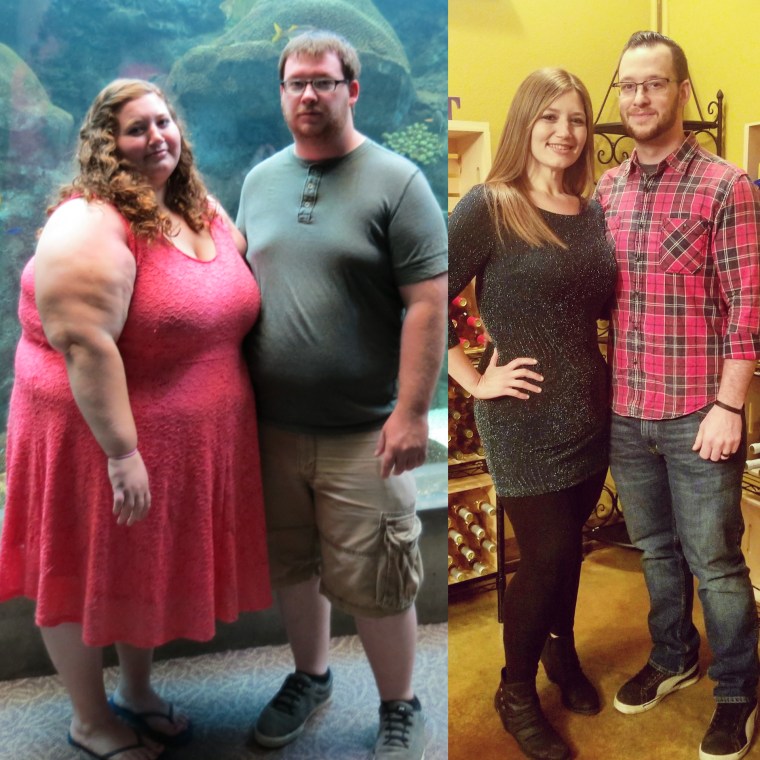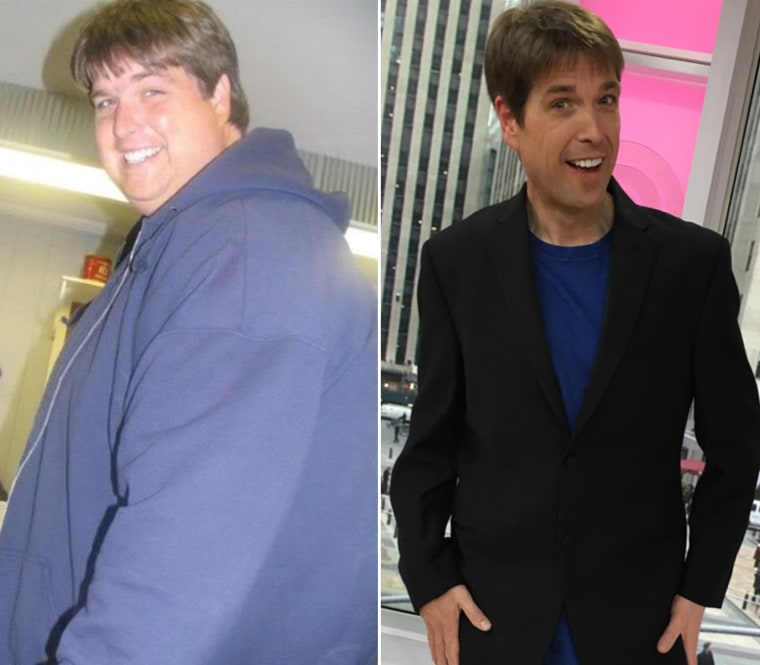In 2018 I interviewed 12 people about their weight-loss success. They were as young as 27 and as old as 57. They lived in Oklahoma, or Minnesota, or New York City. They worked as medical technologists or radio personalities, or house cleaners. They were single, or married or divorced. They had kids, or grandkids, or no kids.
But they all had one thing in common — they all lost weight, a lot of it. Here are some of the strategies they shared that worked for them.
THIS TIME WAS DIFFERENT
Everyone I spoke with had tried to lose weight in the past. Sometimes they succeeded, but then they regained the weight they had lost. In some cases, they regained a lot more.
This time, something — large or small — pushed them to lose weight for good.
Danny Reed called it a “click moment.” It was when he couldn’t keep up with his friends on a hike. His wife Lexi, who worked to help people get Social Security disability benefits, had her click moment when she realized she would be the one who needed those benefits if she didn’t do something about her weight.

Karla Pankow needed physical therapy, and discovered that she loved movement. Vanessa Baldwin’s brother gave her unlimited exercise classes for a month because he was worried about how her weight was affecting her personality. Hoang Nguyen ran into a friend of a friend, and their conversation reminded her how much she used to love to dance.
Sean Anderson had to renew his driver’s license, and his new photo made it clear just how much weight he had gained. Jesse Alexander, who considered himself just a big guy, not someone with a weight problem, heard his doctor tell him he was obese.
Eric Gonzales was diagnosed with type 2 diabetes and high blood pressure. Jerome Wilson got a new job, and hauling his 300-plus pounds up and down the stairs made his knees scream.
THEY CHANGED A LOT ABOUT THEIR LIVES
Often, you’ll hear that small, incremental changes are best if you want to change habits for good. Many of these people found weight-loss success by making major changes instead.
Lexi and Danny Reed set a total-lifestyle-change New Year’s resolution. Initially they planned to stick with it for a month, but they were so successful they made it a permanent part of their lives. “I think it’s better to shock your body and do everything completely differently than to make slow changes,” Danny says.
Jerome Wilson signed up for an intensive weight-loss research study, Mind Your Health. And Gretchen Wood decided to go with weight-loss surgery.
SOMEONE TO LEAN ON FOR SUPPORT
People who lose weight and keep it off don’t go it alone. “I think that support piece is such a critical element,” says Samantha Cassetty, R.D., a New York City-based nutritionist.
Sean Anderson decided he needed to be accountable to more than just himself and his family. So he launched a blog, The Daily Diary of a Winning Loser, where he could share his feelings and experiences with the world.
Danny and Lexi Reed started out leaning on each other, and then began documenting their progress on Instagram. Bill and Elena Rodriguez also committed to losing weight together, and signed up for a weight-loss program that included coaching.
Eric Gonzales relied on the support of peers in his WW (formerly Weight Watchers) in-person and online groups. Vanessa Baldwin had her brother by her side in her exercise program.
A FOCUS ON EXERCISE
The people I spoke with were moving more than they had when they were heavier. For some, that was simply playing with their grandchildren. For others, it meant a solid workout routine.
Some of them started small and built up gradually. Sean Anderson’s first walk lasted less than five minutes. Jerome Wilson wasn’t exercising at all before he enrolled in his research study and he slowly added workouts.
Others jumped into challenging routines. Lexi Reed started with 30-minute elliptical workouts five days a week. Hoang Nguyen began dancing, and added hockey and running. Vanessa Baldwin joined Shred415. Jerome Wilson and Bill Rodriguez worked weight training into their routines. Karla Pankow decided to sign on with a personal trainer.
Many struggled with going to a gym, feeling self-conscious about their body size in that environment. But they pushed themselves past the stares. Having someone else there by their side—a spouse, sibling, or trainer—helped.
“It’s hard to get in there when you’re not feeling your best and you’re not in shape. I give major props to these people who got out there and did it,” Cassetty says.
Some found exercise programs they enjoyed so much they trained to be instructors. Jesse Alexander loved the group energy at CycleBar, and he now leads classes there. And Vanessa Baldwin is an instructor at Shred415.
Finding an activity you enjoy is key to sticking with an exercise routine. “If you’re going to spin class to burn a ton of calories but you hate it, there’s no reason to put yourself through that. If you hate it it’s going to be hard to sustain,” Cassetty says.
She also points out that any amount of exercise is going to be good for you. “People tend to get overwhelmed with exercise. They think they need an hour or an hour and a half to get to the gym, change, work out, shower, and change back. That’s where people trip up — they’re letting that ideal prevent them from even working out for 15 minutes,” she says.
THEY TOOK A HARD LOOK AT THEIR FOOD CHOICES
While they all took their own paths toward healthier food choices, there were some common trends:
They cut out sugar. Soda, sweet tea and juice were almost always the first things to go as part of a weight-loss plan. Just replacing Mountain Dew with water led Karla Pankow to drop 10 to 15 pounds. Sean Anderson cut out refined sugar completely.
They ate more produce and protein and less processed and fried food. Cassetty says, calorie for calorie, less-processed meals give a metabolic boost over more-processed meals. “Your body has to work harder to extract the material it needs from a less-processed meal,” she says.
They chose healthier carbs. Carbs weren’t out entirely for most people, but the carbs they ate came mostly from fruit, vegetables like sweet potatoes, and beans, rather than grains.
Cassetty notes that the trouble with grains like oatmeal or quinoa is that they are easy to overconsume. “Standard portions are a half cup, or a half an English muffin, or a slice of toast. That’s not terribly filling,” she says.
They ate protein in the morning. Most people started their days with breakfast, usually including eggs or some type of protein. “When we’re trying to lose weight it’s important to get enough protein in the morning,” Cassetty says.
That’s because at night, your body is naturally breaking down muscle. Eating protein activates the rebuilding process. “If you don’t stack your morning with protein you’re missing that opportunity to spark that rebuilding phase,” she says.
They thought through what they would eat and controlled their portions. Jesse Alexander planned his portions and he mostly cooked at home, where he can control the ingredients. Jerome Wilson wrote down everything he ate. The Rodriguezes planned their meals in the morning and chopped up to 10 different kinds of veggies to prep for the day.
The Reeds looked for healthier versions of the foods they liked. They made pizza on a tortilla instead of a stuffed crust, or created their own taco salad instead of heading to Taco Bell.
THEY NO LONGER TURN TO FOOD FOR COMFORT
Emotional eating was behind the weight gain for many people, so they needed to learn new ways to manage their emotions.
“I changed my attitude about food and changed my attitude about how I want to live. I take my dog for a walk, or take a nap, or watch a funny movie on TV or spend time with God,” says Gretchen Wood.
Some, like Elena Rodriguez and Gretchen Wood, had to battle depression, which was contributing to their weight gain.

THEY DIDN’T CONNECT MUCH WITH THEIR DOCTORS
Most people saw their doctors, and some with multiple health conditions saw a bunch of different specialists. But mostly they didn’t turn to their doctors for weight-loss advice.
Some even wished their doctors had been more assertive about pointing out the ways in which their weight was affecting their health. “I was in and out of doctors’ offices constantly, but I never had a physician talk to me about my weight,” Pankow says. “I think for 25 years I kept waiting for doctors to tell me I was too fat. Because I never heard it, I thought I was fine.”
THEIR LIVES CHANGED. SOMETIMES, A LOT
Once they lost weight, the heaviest people in the group could do simple things they couldn’t do before. Things like ride a roller coaster, fit in a restaurant booth, sit in an airplane seat, or just get down on the floor to play with their grandchildren.
And for some people, losing weight led to new careers. Lexi and Danny Reed both now blog full time about their weight loss. Jesse Alexander and Vanessa Baldwin teach exercise classes. Karla Pankow achieved her dream of being a firefighter, a job she never would have been able to manage when she was carrying a lot of extra weight.
MORE WEIGHT-LOSS SUCCESS STORIES
- The daily practice that helped this woman lose 50 pounds
- How a spreadsheet helped this man lose 60 pounds
- These two economists used 'meta rules' to drop 120 pounds
- The 80/20 rule helped this woman lose weight
Want more tips like these? NBC News BETTER is obsessed with finding easier, healthier and smarter ways to live. Sign up for our newsletter and follow us on Facebook, Twitter and Instagram.


